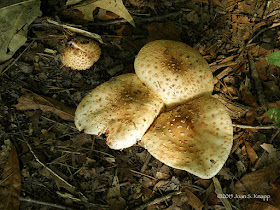July 13th. I started to walk again at Fort Yargo State Park
in Winder, Georgia. One of my favorite walks is from the Group Shelter A to the Old Fort and back.This
is a rewarding walk for viewing wildflowers and I’ve been trying to walk it
weekly and document the wildflowers I see.
The early spring wildflowers have finished blooming; it was time to
watch the developing fruit. A few late spring/summer wildflowers were blooming
now.
The seed capsules were still developing on this Strawberry
Bush (Euonymus americanus). The seed
capsules had swollen slightly but then had remained the same size, and no sign
of pink color yet.
A few Starry Rosinweeds (Silphium
astericus) were still blooming in the shade by the trail just beyond the
Strawberry Bush.
A new flower had appeared in the open area beyond the first
woods. A Bushy Seedbox (Ludwigia
alternifolia) had begun blooming. The flowers are really ‘fragile;’ the
petals will fall off the flowers easily if touched. Flowers of Ludwigia sp. are
easy to recognize with their...
large bulb-shaped stigmas.
A couple of Carolina Desert-chicory (Pyrrhopappus carolinianus) plants were also blooming. These flowers
are a lemon yellow compared with the golden yellow of most of the other dandelion-like flowers and easy to recognize from a distance.
For the first time I saw a ‘ripe’ blackberry. Even ripe,
they aren’t very sweet.
Atlantic Pigeonwings (Clitoria
mariana) were blooming close to the ground. The vines will climb, but not
very aggressively.
The berries on the surviving Solomon’s Seal (Polygonatum biflorum) plants hadn’t
ripened yet. These take a long time to ripen.
Just past the first bridge I noticed a number of European
Hornets (Vespa crabro) feeding on sap
that was oozing from a tree trunk.
A Five-lined Skink, probably Plestiodon
fasciatus,
was sunning itself on a log nearby where I usually see the Eastern Fence Lizard.
A number of large bolete mushrooms – several were 6 to 7
inches across – had grown during the previous few days. These can be challenging to identify; maybe next year.
A little further along the trail, the seed capsules on the
Pipsissewa (Chimaphila maculata) were still doing well, as were the…
seed capsules on the Eastern Sweetshrub (Calycanthus floridus) plant, and the..
seed capsules on the Wild Yam (Dioscorea
villosa) vine. Once I found them, I haven’t had
much doubt that they would survive to maturity; my only regret is that I missed
the very early stage of their development.
Fewer of the Nakedflower Ticktrefoils (Desmodium
nudiflorum) were blooming. Most, however, were setting seed lomonts; these
will break into one-seeded joints when mature.
The seed capsules on the witchhazel bush (Hamamelis sp.) were unchanged, but still
doing well.
The developing flower buds for this season, that I first saw
the previous week, were unchanged.
The seed capsules were still healthy on the Mountain Azalea
(Rhododendron canescens) bush at the
top of the cliff. There appear to be far fewer than last year.
The bracket fungus. It looked a little ‘worn’ compared with
a couple of weeks previously.
Nearby, I spotted a small cluster of Amanita sp. mushrooms.
Then on down from the cliff towards the Fishing Area.
(To be continued…)
Related posts:
- Summer At Fort Yargo State Park: Shelter A To The Old Fort,July 6th, 2015
(Part 1)
























No comments:
Post a Comment